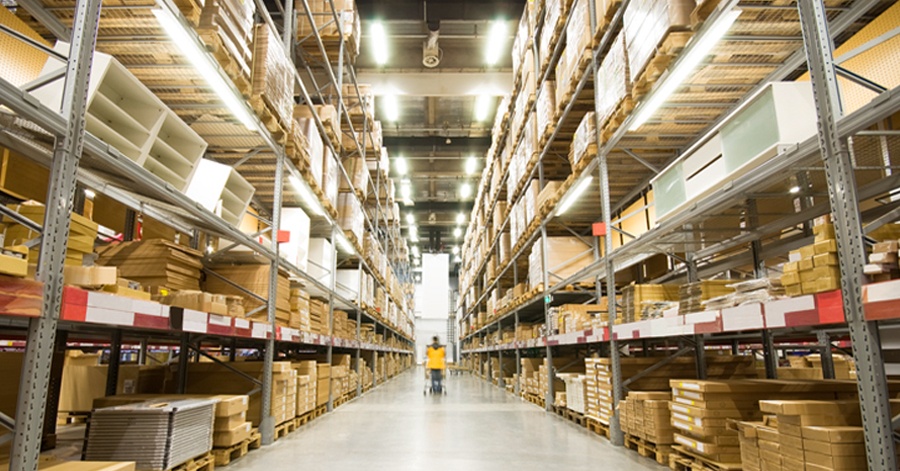
Since warehouses can be hazardous workplaces, warehouse safety tips can protect your workforce, bolster your bottom line, and save your organization thousands of dollars. Across the United States, approximately 4% of warehouse workers are affected by illnesses or work-related injuries that involve job restriction, lost work, or transfer every year.
Considering there are an estimated 145,000 individuals working in warehousing, approximately 5,800 of them will experience a work-related illness or injury every year. These numbers coincide with the amount of machinery and heavy equipment being used on an everyday basis. Based on OSHA statistics, some of the most common warehouse hazards are:
- Improper stacking of products
- Injuries from repetitive motion
- Improperly using forklift
- Inadequate provisions for fire safety
- Failure to properly use personal protective equipment
- Slip, trip, falls hazards as well as exit obstructions
When it comes to keeping your warehouse safe, warehouse safety tips are profitable. By reducing the number of injuries, you will pad your bottom line, bolster employee morale, and create a more productive environment. Continue reading to learn a few helpful safety tips for warehouse workers.
Warehouse Safety Tips Starts with Training
It doesn't matter about how safe the warehouse is if employees are not trained properly on regulations for safety. It's vital to hold regular safety training for both new hires as well as veterans.
The training should be conducted by a skilled professional safety expert. It should also include various methods of testing to ensure comprehension. Even though testing may be wildly unpopular, it ensures the vital information is retained and understood, which leads to adoption in the workplace.
If your warehouse includes heavy equipment operators, the safety certification and training should be of the utmost importance. This is because heavy machinery injuries are exceptionally dangerous and even fatal.
Keep the Workplace Clean and Tidy
If left unattended, empty boxes, debris, empty pallets, discarded shrink-wrap, and a variety of other items will naturally accumulate in the warehouse. These items can and will become dangerous fall hazards if left unattended.
One quintessential warehouse safety tip is to keep the floor free from all types of debris. You should also make sure you keep cleaning products, oil, water, and other objects in its proper place to prevent spills that can result in a slip and fall injury.
Everything in your warehouse should have a designated place. Most importantly, your workforce should understand where everything belongs and ensure items are properly stored. This simple step can minimize the possibility of mishaps caused by misplaced items.
Always Use Proper Stacking Techniques
Stacks of packages that are uneven can be unsafe and unstable. Anytime items are improperly stacked, a whole stack of items or a single item can fall and injure employees.
It's imperative the heaviest items are always stacked on the bottom, and all items are stacked evenly. Choosing to invest in high-quality racking equipment up-to-date with all standards of safety is a crucial aspect to the safety of your workforce.
Ensure the Use of Effective Lighting
One of the most effective warehouse safety tips is to utilize effective warehouse lighting. If your workers are unable to see hazards, it becomes exponentially more difficult to avoid these hazards.
When you have a well-illuminated warehouse, it will drastically minimize the likelihood of a related accident. Throughout the warehouse, walkways and everywhere else should have even, strong lighting. In addition, work areas associated with detail work should have task lighting implemented.
Safety Culture
Essentially, management should be responsible for setting the tone for safety behavior in the organization. Even so, the most effective approach to safety is to create an environment where everyone prioritizes their own safety and the safety of their coworkers, which explains the idea of creating a safety culture.
With a strong organizational culture of safety, everyone in the workforce proactively realizes the importance of safety and proactively works to attain it. In the end, a culture of safety cannot be maintained or created through sporadic meetings.
In contrast, safety should be a daily mainstay permeating throughout the operations of the warehouse. The only way to achieve this goal is to regularly review safety regulations and alter them if you do not feel their adequately keeping your workforce safe.
Proactively Manage Slips and Falls
In any office, warehouse, or other workplace, slips and falls are the most common accident. To prevent falls in your warehouse, it's vital to train your workforce to be aware of their surroundings. You can use various signs and types of signage to help your workers keep their mind and eyes on task. Other warehouse safety tips to prevent slip and fall accidents include:
- Install adequate guard rails any instance large gaps exist between floors
- Keep ridges and steps to a minimum
- Install anti-slip tape on the floors to promote a sure footing
Contact Premier Safety Partners
Considering the large number of hazards and risks existing in any given warehouse, it makes dollars and sense for owners to take a proactive stance on safety. At Premier Safety Partners, we bring decades of experience helping warehouses reduce injuries and bolster productivity through effective safety initiatives. Contact Premier Safety Partners today to schedule an onsite consultation.





